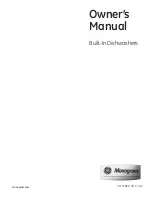
6.
press the two levers and pull forward the
drainage duct to let the water flow out;
7.
when the container is full of water, put the
drainage duct back again and empty the
container;
repeat this operation until water stops flow-
ing out;
8.
if necessary clean the pump (refer to the
section ‘Cleaning the pump’ );
9.
close the drain pump door.
When you drain the water with the emergency
drain procedure, you must activate again the
drain system:
1.
Put 2 litres of water in the main wash com-
partment of the detergent dispenser.
2.
Start the programme to drain the water.
Installation
Unpacking
All transit bolts and packing must be removed
before using the appliance.
You are advised to keep all transit devices so
that they can be refitted if the machine ever has
to be transported again.
After removing all the
packaging, carefully
lay machine on it's
back to remove the
polystyrene base from
the bottom.
Remove the power
supply cable and the
hose from the hose
holders on the rear of
the appliance.
Unscrew the three
bolts.
Slide out the relevant
plastic spacers.
Open the porthole,
remove the polystyr-
ene block fitted on
the door seal and pull
out all items from the
drum.
Fill the smaller upper
hole and the two
large ones with the
corresponding plastic
plug caps supplied in
the bag containing
the instruction book-
let.
Positioning
Install the machine on a flat hard floor. Make
sure that air circulation around the machine is
not impeded by carpets, rugs etc. Check that
the machine does not touch the wall or other
kitchen units. Level the washing machine by
raising or lowering the feet. The feet may be
tight to adjust as they incorporate a self locking
nut, but the machine MUST be level and stable.
Any necessary adjustment can be made with a
spanner.
Accurate levelling prevents vibration, noise and
displacement of the machine during operation.
Never place cardboard, wood or similar materi-
als under the machine to compensate for any
unevenness in the floor.
23
www.zanussi.com






































